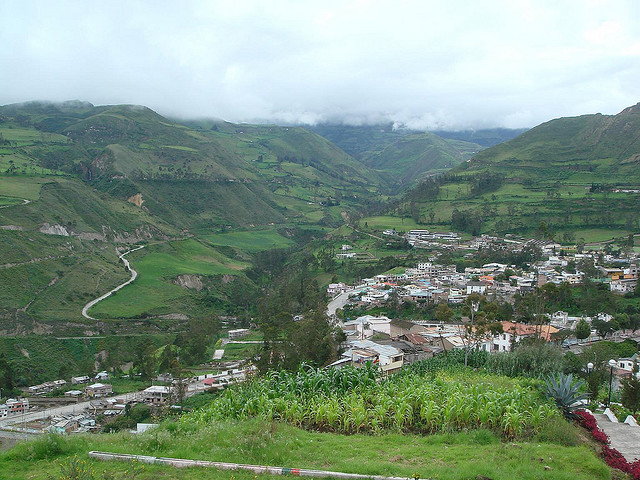Visiting Alausí and taking the Nariz del Diablo Train Ride
Set on the edge of a gorge with a giant statue of patron saint San Pedro dominating the town, Alausí is a fittingly dramatic departure point for the most dramatic train ride in Ecuador—La Nariz del Diablo (Devil’s Nose). When train service resumes from Riobamba in mid-2012, the train stops in Alausí in the mid-morning before embarking on its two-hour descent and then returning to Riobamba in the early afternoon. Some people shorten the train ride by boarding here for the best part, making Alausí an alternate overnight stay to Riobamba. It is also the starting point for heading south to Achupallas and hiking the Inca Trail to Ingapirca.

Aside from the train service, Alausí springs to life for market day on Sunday, when indigenous people come down from the nearby páramo wearing their best and most colorful clothing. You can get a closer look at the statue of Saint Peter and admire the panoramic views by climbing the Lluglli hill.
The town’s festival is celebrated on June 29 with bullfights and colorful parades.
Nariz del Diablo Train Ride
Alausí’s train station, the goal of most visitors, sits behind the small plaza at the north end of 5 de Junio. The train through the famous Nariz del Diablo (Devil’s Nose) to Sibambe (departs 8 a.m., 11 a.m., and 3 p.m. Tues.–Sun., $20 pp) takes 2.5 hours. When train service from Riobamba to Alausí resumes, the train will leave Riobamba at 6:30 a.m., stopping in Alausí three hours later.
Buying tickets in advance is strongly recommended, especially for weekend trips, because standing is not allowed. You can buy a ticket at the train station in Alausí (tel. 3/293-0126) or make a reservation at the train station in Riobamba (Av. de los Volcanes, tel. 3/296-7316 or 3/296-1038) and collect the ticket at the train station in Alausí.
The Devil’s Nose was one of the most incredible feats of railroad engineering when it was completed in the early 1900s. The train descends through a hair-raising series of switchbacks that are so tight the entire train has to back up momentarily to fit through. Just below the switchbacks, the train stops near Sibambe, turns around, and climbs back through the entire route. For the best views, sit on the righthand side of the train if you can. Riding on the roof is now prohibited following the deaths of two Japanese visitors in 2007.
If you are coming from Riobamba, the return journey takes all day, but you can shorten it by taking the bus back from Alausí to Riobamba (2 hours, $1.50). Buses from Alausí also run to Quito and Cuenca.
Newsletter Signup
By clicking ‘Sign Up,’ I acknowledge that I have read and agree to Hachette Book Group’s Privacy Policy and Terms of Use
Accommodations and Food in Alausí
Alausí has a small selection of hotels, which is likely to grow quickly now that the trains runs more frequently. One block from 5 de Junio, Hotel Europa (García Moreno 159 and Chile, tel. 3/293-0200, $5–8 pp) is a good budget option with old wooden balconies, simple guest rooms with shared or private baths, and a Chinese restaurant (8 a.m.–10 p.m. daily, $3– 4). Hotel Pan-Americano (5 de Junio and 9 de Octubre, tel. 3/293-0156, $6–10 pp) also has decent guest rooms with shared or private baths and a restaurant downstairs (8 a.m.– 10 p.m. daily, $3–4).
One of the best places in town is Hostería La Quinta (Eloy Alfaro 121, tel. 3/293-0247, $36 s, $56 d, breakfast included), with comfortable guest rooms and great views of the train line. It fills up fast, so book in advance.
About three kilometers outside town, Hostería Pircabamba (Villalva and Pedro de Loza, tel. 3/293-0180, $20 pp, breakfast included) has traditional whitewashed brick-and-wood guest rooms with views of Alausí and the surrounding valleys. Horseback excursions are available.
Some of the best food in Alausí can be found in the various hotel restaurants, including Hotel Pan-Americano and Hotel Europa. Inside the train station, Café La Higuera (tel. 3/293-1582, 8 a.m.–6 p.m. daily, $2–3) is a good place to grab breakfast before the train ride or a set lunch on the way back. Right next to the station, El Mesón de Tren (Ricaurte and Eloy Alfaro, tel. 3/293-0243, 8 a.m.–6 p.m. daily, $3) offers filling local specialties such as roast pork and llapingacho, a potato dish.
Information and Services
You can exchange traveler’s checks at the Banco de Guayaquil (5 de Junio and Ricaurte), on the ground floor of the Municipal Building near the train station. The post office (García Moreno and 9 de Octubre) is one block uphill from 5 de Junio, past the Hotel Pan-Americano. A covered market spreads along García Moreno between Pedro Loza and Chile, uphill from 5 de Junio.
Buses head to Ambato (3 hours, $3), Cuenca (4 hours, $5), Guayaquil (5 hours, $5), Quito (5 hours, $6), and Riobamba (2 hours, $1.50) from the corner of 9 de Octubre and 5 de Julio. More buses pass on the highway up the hill ($1 by taxi), picking up passengers at the gas station on the Panamericana.
To begin the Inca Trail, occasional trucks bound for Achupallas, where the market is on Saturday, leave from 5 de Junio. There is more transportation available 30 minutes south at the road junction at La Moya, just after the river crossing.
Newsletter Signup
By clicking ‘Sign Up,’ I acknowledge that I have read and agree to Hachette Book Group’s Privacy Policy and Terms of Use

